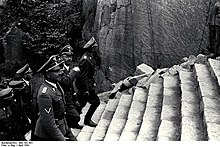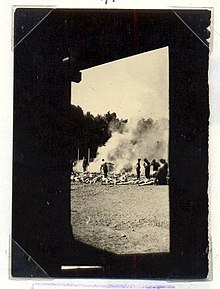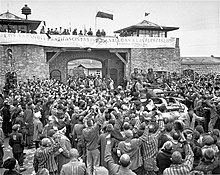Photography of the Holocaust

Photography of the Holocaust is a topic of interest to scholars of the Holocaust. Such studies are often situated in the academic fields related to visual culture and visual sociology studies.[2][3][4][5][6][7][8][9] Photographs created during the Holocaust also raise questions in terms of ethics related to their creation and later reuse.[3]: abstract
Origin of the photos
[edit]Much of the photography of the Holocaust is the work of Nazi German photographers.[7] Some originated as routine administrative procedure, such as identification photographs (mug shots); others were intended to illustrate the construction and functioning of the camps or prisoner transport.[5] There were also photographs of concentration camps authorized for use by German media, those appeared in print around 1933–1936 in German newspapers and magazines such as Deutsche Illustrirte Zeitung or Münchner Illustrierte Presse.[5] A small number of pictures appeared in later years, vetted by propaganda and censorship officials before publication.[5]


Many photographs of the Holocaust are taken by unidentified authors, but others are known. Nazi German photographers of the Holocaust who acted in their official capacity include Bernhard Walter, Friedrich Franz Bauer, Franz Wolf, Albert Rum and Franz Suchomel.[5] The destruction of the Warsaw Ghetto was methodically documented in the well-illustrated Stroop Report.[10] Some photographs were taken by the camp prisoners themselves, for example by Wilhelm Brasse[11] or Francisco Boix, working as aides for their Nazi overseers.[5] There were also photographs taken in the ghettos by their Jewish inhabitants, some with official permission, some in secrecy as an act of defiance and for evidence purposes.[12] Jewish photographers of the ghetto life included Henryk Ross and Mendel Grossman, both of whom documented the Łódź Ghetto.[12] A number of other photographs of the Jewish ghetto life come from Nazi personnel and soldiers, many of whom treated those locales as tourist attractions.[12] Unofficial photographs of the Holocaust were taken by, among others, Hubert Pfoch,[5] Joe Heydecker,[13] Willy Georg[14] and Walter Genewein.[15]


Other photographs were taken during the liberation of the camps by photographers attached to Allied units which arrived to secure them.[5] Such photographs started appearing from mid-1944, and gained wider notoriety in the spring 1945.[5] Most Allied military photographers remain anonymous as they were seldom credited, unlike the press correspondents who published some of the first photo exposés of the camps; the latter included Lee Miller, Margaret Bourke-White, David Scherman, George Rodger, John Florea and William Vandivert.[5] Because of the Cold War, many photographs made by the Soviets were treated with suspicion in the West, and received little coverage until decades later.[12] Holocaust photography also includes aerial reconnaissance photos made by Allied aircraft.[6]
Many photographs were destroyed, some accidentally, as collateral damage during the war, others on purpose, in attempts by perpetrators of the atrocities to suppress the evidence.[5] Conversely, some Nazi photographs were stolen, hidden and preserved as evidence of atrocities by individuals such as Francisco Boix or Joe Heydecker.[5][13]
The total number of surviving Holocaust-related photos has been estimated at over two million.[7]
Usage of the photos
[edit]A number of surviving photographs documenting Holocaust atrocities were used as evidence during post war trials of Nazi war crimes, such as the Nuremberg trials.[5] They have been used as symbolic, impactful evidence to educate the world about the true nature of Nazi atrocities.[6][8]
Historical photographs are considered valuable artifacts for historical studies and memorial institutions such as museums and galleries.[5][6] There have been a number of gallery exhibits dedicated to this topic.[6] They are used by scholars to refine understanding of historical events, in a form of visual archaeology.[2][6] In addition to the photos themselves, caption of the photos have been analyzed as well, as they can be helpful in understanding framing biases; for example the same photo captioned in Russian might describe the victims as Soviet citizens, in Polish, as Polish citizens, and in Yiddish, as Jews.[6][12]
At the same time, some have criticized whether unconditional public access to photographs of atrocities is ethical (as they were not taken with the subjects' consent, and have been known to cause distress to the subjects) and educational (as they have been accused of being trivialized in some contexts, or used out of context or with improper attribution).[3][12] Demand for Holocaust atrocity photographs has resulted in a number of fake images turning up at auctions.[12]
Inmate photographs were analyzed in a 2021 French documentary, From Where They Stood.[16]
See also
[edit]- The Holocaust and social media
- Sonderkommando photographs
- List of photographs considered the most important
References
[edit]- ^ Maltz, Judy (3 March 2011). "Holocaust Studies / A picture worth six million names". Haaretz. Retrieved 23 September 2018.
- ^ a b Sroka, Marek (2011-04-01). "Identifying and Interpreting Prewar and Wartime Jewish Photographs in Polish Digital Collections". Slavic & East European Information Resources. 12 (2–3): 175–187. doi:10.1080/15228886.2011.594986. ISSN 1522-8886. S2CID 144443757.
- ^ a b c Crane, Susan A. (2008). "Choosing Not to Look: Representation, Repatriation, and Holocaust Atrocity Photography". History and Theory. 47 (3): 309–330. doi:10.1111/j.1468-2303.2008.00457.x. ISSN 1468-2303.
- ^ Finder, Gabriel N. (2020). "'A Horrific Impression of Jewish Martyrdom': Regarding Extermination of Polish Jews: Album of Pictures". The Journal of Holocaust Research. 34 (4): 388–408. doi:10.1080/25785648.2020.1820132.
- ^ a b c d e f g h i j k l m n Milton, Sybil (1999-12-01). "Photography as evidence of the Holocaust". History of Photography. 23 (4): 303–312. doi:10.1080/03087298.1999.10443338. ISSN 0308-7298.
- ^ a b c d e f g Farmer, Sarah (2010-02-01). "Going Visual: Holocaust Representation and Historical Method". The American Historical Review. 115 (1): 115–122. doi:10.1086/ahr.115.1.115. ISSN 0002-8762.
- ^ a b c Hirsch, Marianne (2001-04-01). "Surviving Images: Holocaust Photographs and the Work of Postmemory". The Yale Journal of Criticism. 14 (1): 5–37. doi:10.1353/yale.2001.0008. ISSN 1080-6636. S2CID 162219199.
- ^ a b Stańczyk, Ewa (2014-09-02). "The Absent Jewish Child: Photography and Holocaust Representation in Poland". Journal of Modern Jewish Studies. 13 (3): 360–380. doi:10.1080/14725886.2014.951536. ISSN 1472-5886. S2CID 143838360.
- ^
- Zelizer, Barbie (2000-12-01). Visual Culture and the Holocaust. A&C Black. ISBN 978-1-4411-9331-5.
- Brennen, Bonnie; Hardt, Hanno (1999). Picturing the Past: Media, History, and Photography. University of Illinois Press. ISBN 978-0-252-06769-3.
- Liss, Andrea (1998). Trespassing Through Shadows: Memory, Photography, and the Holocaust. U of Minnesota Press. ISBN 978-0-8166-3060-8.
- Zelizer, Barbie (December 1998). Remembering to Forget: Holocaust Memory Through the Camera's Eye. University of Chicago Press. ISBN 978-0-226-97972-4.
- Blanco, Maria del Pilar; Peeren, Esther (2013-08-29). The Spectralities Reader: Ghosts and Haunting in Contemporary Cultural Theory. A&C Black. ISBN 978-1-4411-2478-4.
- Struk, Janina (2004-03-04). Photographing the Holocaust: Interpretations of the Evidence. Bloomsbury Academic. ISBN 978-1-86064-546-4.
- ^ Jürgen Stroop (2009). Andrzej Żbikowski (ed.). Żydowska dzielnica mieszkaniowa w Warszawie już nie istnieje! / Es gibt keinen jüdischen Wohnbezirk in Warschau mehr! (PDF). Warsaw: Instytut Pamięci Narodowej, Żydowski Instytut Historyczny. pp. 10–18. ISBN 978-83-7629-455-1.
- ^ "Auschwitz photographer Wilhelm Brasse dies at 95". Reuters. 2012-10-24. Retrieved 2020-03-20.
- ^ a b c d e f g Crew, David (September 2006), Review of Hesse, Klaus; Springer, Philipp; Rürup, Reinhard, Vor aller Augen: Fotodokumente des nationalsozialistischen Terrors in der Provinz and Kramer, Sven, Die Shoah im Bild and Rolf Sachsse, Die Erziehung zum Wegsehen: Fotografie im NS-Staat and Sachsse, Rolf, Die Erziehung zum Wegsehen: Fotografie im NS-Staat and Struk, Janina, Photographing the Holocaust: Interpretations of the Evidence, H-German, H-Review, retrieved 2020-03-20
- ^ a b "Where is thy brother Abel? Documentary Photographs of the Warsaw Ghetto - Joe J. Heydecker | www.yadvashem.org". brother-abel.html. Retrieved 2020-03-20.
- ^ "Popular Photography". Popular Photography: World's Largest Imaging Magazine: 18. December 1994. ISSN 1542-0337.
- ^ Fraser, Nick (1999-08-13). "Cold gaze of a Nazi camera". The Daily Telegraph. ISSN 0307-1235. Archived from the original on 2014-06-12. Retrieved 2020-03-20.
- ^ Rapold, Nicolas (14 July 2022). "'From Where They Stood' Review: Auschwitz, as Seen by Prisoners". The New York Times. Retrieved 20 July 2022.
Further reading
[edit]- Scharnberg, Harriet (2018). Die "Judenfrage" im Bild: Der Antisemitismus in nationalsozialistischen Fotoreportagen (in German). Hamburger Edition HIS. ISBN 978-3-86854-943-0.
- Shneer, David (2011). Through Soviet Jewish Eyes: Photography, War, and the Holocaust. Rutgers University Press. ISBN 978-0-8135-4884-5.
External links
[edit]- Auschwitz Album: photos taken by the SS (Yad Vashem)
- Mendel Grossman collection: photos of the Łódź Ghetto (US Holocaust Memorial Museum)
- Höcker Album: photos of Auschwitz-Birkenau taken by an SS officer (US Holocaust Memorial Museum)
- Henryk Ross collection: photos of the Łódź Ghetto (Art Gallery of Ontario)
